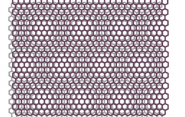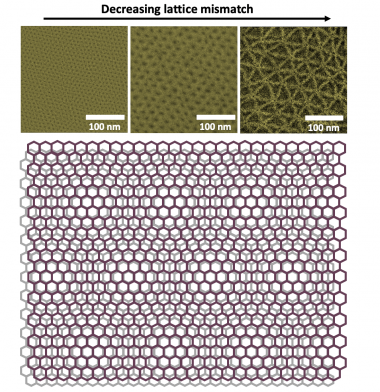Study brings a new twist (and valuable properties) to materials science

In recent years, researchers have learned that twisting certain materials at specific angles can form what are known as “moiré materials,” which elicit previously undiscovered properties. These properties can lead the way toward discoveries of exotic physical phenomena such as new correlated states and developments of intelligent sensors, and have potential applications in such fields as astronomy, health care, and remote sensing.
 This field of research, known as “twistronics,” has advanced greatly in a short time, but there’s still much to discover.
This field of research, known as “twistronics,” has advanced greatly in a short time, but there’s still much to discover.
For one thing, accurately controlling the twist of the materials during their growth is tricky. Now, a group of researchers led by Fengnian Xia, professor of electrical engineering, has developed a method that allows them to directly grow tunable moiré materials. The results of their work are published in Nature Materials.
Moiré materials, named for their periodic patterns, are typically fabricated by stacking atomically thin layers of a material and providing a slight twist. “In general, almost all twist angles are as stable (or unstable) as others,” said Matthieu Fortin-Deschênes, a postdoctoral fellow in Xia’s lab and lead author of the study. “So it's very hard to control this twist angle.”
Instead of twisting the materials, the researchers introduced the lattice constant mismatch of two different layers by leveraging the concentration of materials within a group of the periodic table - sulfur and selenium, for instance. The two aligned layers with lattice mismatch lead to tunable moiré periodicity from 10 to 45 nanometers.
“This allows us to tune the lattice parameters,” Fortin-Deschênes said. “And this is an equilibrium state, so it's the most stable state, and it's much easier to target a specific moiré pattern that way.”
And by doing so, the researchers can better control and scale up these materials, which have demonstrated such valuable properties as unique optical absorption and emission properties. As a result, they hold significant potential for the development of innovative technologies.
“Our study lays the groundwork to harness the emerging physical properties of moirés in future technologies such as intelligent sensors,” Fortin-Deschênes said. “Moreover, the developed understanding of the growth mechanisms may allow better control over the synthesis of other 2D materials and their heterostructures.”
The moiré growth in the Nature Materials study was demonstrated on transition metal dichalcogenides, which are semiconducting 2D materials. However, the method they used is general and could be extended to a wide range of materials such as 2D magnetic or ferroelectric materials, as well as graphene-based materials.
The next challenge for the researchers is increasing the size of the grown moirés.
“In our study, we used an amorphous substrate for the synthesis,” he said. “In principle, using a crystalline substrate such as sapphire would allow us to scale our approach.”

